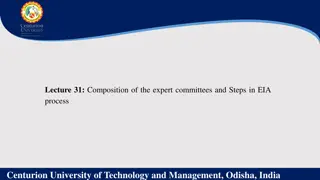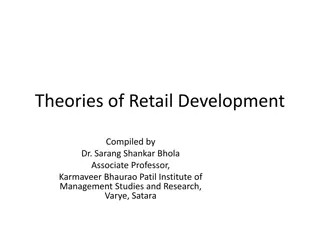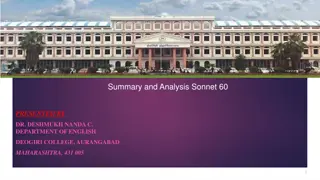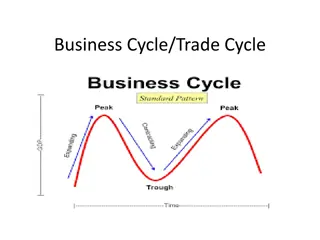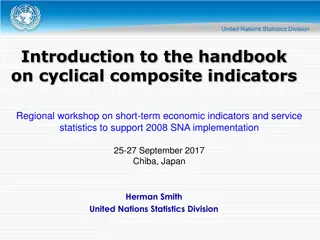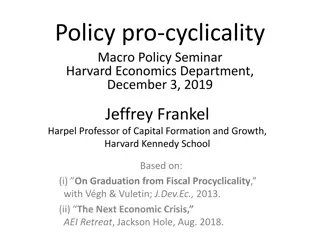Development of new quality assurance guidelines for online learning
Explore the development of new quality assurance guidelines for online learning, the role of Quality and Qualifications Ireland in maintaining national qualifications, and the principles and framework of quality assurance in Irish higher education institutions. Understand the continuous improvement
3 views • 29 slides
Global Climate Models
Scientists simulate the climate system and project future scenarios by observing, measuring, and applying knowledge to computer models. These models represent Earth's surface and atmosphere using mathematical equations, which are converted to computer code. Supercomputers solve these equations to pr
3 views • 15 slides
Relevance of Countercyclical Fiscal Policy and Fiscal Acyclicality
This literature review examines the effectiveness of countercyclical fiscal policies in stabilizing output and enhancing welfare, with a focus on the correlation between public spending cycles and GDP cycles. The study analyzes examples from Sweden and Argentina to showcase the impact of fiscal poli
2 views • 29 slides
Analysis of John Webster's Play "The White Devil" and Its Themes
John Webster's play "The White Devil" is a revenge tragedy that explores themes of revenge, retribution, and cyclical nature of vengeance. The complex characters, intricate plot, and genre-bending elements make it a significant work in English literature, despite initial poor reception. The play del
8 views • 27 slides
Understanding Disequilibrium and Corrective Measures in Balance of Payments
Causes of disequilibrium in Balance of Payments (BoP) include cyclical, structural, and short-run imbalances. Cyclical disequilibrium relates to trade cycles, structural imbalance arises from sectoral changes impacting trade relations, and short-run imbalances are temporary and often related to borr
4 views • 14 slides
System Models in Software Engineering: A Comprehensive Overview
System models play a crucial role in software engineering, aiding in understanding system functionality and communicating with customers. They include context models, behavioural models, data models, object models, and more, each offering unique perspectives on the system. Different types of system
3 views • 33 slides
Understanding Species Interactions and Predator-Prey Dynamics
Species interactions refer to the associations between different organisms that can be positive or negative, influencing the growth and evolution of populations. Predation is a key interaction where one organism hunts and feeds on another. In predator-prey dynamics, populations fluctuate in a cyclic
3 views • 36 slides
Understanding Input-Output Models in Economics
Input-Output models, pioneered by Wassily Leontief, depict inter-industry relationships within an economy. These models analyze the dependencies between different sectors and have been utilized for studying agricultural production distribution, economic development planning, and impact analysis of i
8 views • 7 slides
Exploring Growth Opportunities in Small Semiconductor Equipment Companies
Dive into the transformation of the semiconductor equipment industry from cyclical to growth-driven, backed by data from world semiconductor trade statistics, and insights from companies like Taiwan Semiconductor (TSM). Discover the increasing complexity in semiconductor packaging techniques and how
4 views • 41 slides
6 Ways Excavation Contractors Can Diversify Their Service
As a Helena excavating contractor, you're used to the cyclical nature of the construction\nindustry. Rather than suffering through the slow periods, why not diversify the services\nyou offer? Adding complementary contracting and Helena excavation services allows\nyou to keep your crew working year-r
0 views • 4 slides
Understanding Models of Teaching in Education
Exploring different models of teaching, such as Carroll's model, Proctor's model, and others, that guide educational activities and environments. These models specify learning outcomes, environmental conditions, performance criteria, and more to shape effective teaching practices. Functions of teach
2 views • 20 slides
Steps in the EIA Process at Centurion University, Odisha, India
The Environmental Impact Assessment (EIA) process at Centurion University involves crucial steps such as screening, scoping, baseline data collection, impact prediction, mitigation measures, public hearing, decision making, and monitoring. It is a cyclical process that requires thorough assessment o
0 views • 4 slides
Understanding Models of Teaching for Effective Learning
Models of teaching serve as instructional designs to facilitate students in acquiring knowledge, skills, and values by creating specific learning environments. Bruce Joyce and Marsha Weil classified teaching models into four families: Information Processing Models, Personal Models, Social Interactio
1 views • 28 slides
Theories of Retail Development and Environmental Adaptation
The theories of retail development explore different frameworks such as Environmental, Cyclical, and Conflictual theories to understand how retail evolves and adapts to changing environments. The Environment Theory emphasizes the importance of adapting to survive in a competitive market, while the C
0 views • 14 slides
Transience Poem by Sarojini Naidu - Reflections on Life's Impermanence
In "Transience," Sarojini Naidu conveys a message of optimism amidst life's sorrows. Through vivid imagery, she emphasizes the impermanence of pain and the certainty of new joys and hopes. The poem reflects on the cyclical nature of life, where sorrow gives way to renewal and growth, drawing paralle
0 views • 12 slides
The Eternal Role of Rain in Walt Whitman's Poetry
The poem "The Voice of the Rain" by Walt Whitman explores the eternal significance of rain in nurturing, quenching, and purifying the Earth. Through poetic language, Whitman emphasizes the cyclical nature of rain, comparing it to music as both elements enliven the world and return to their origins.
0 views • 9 slides
Analysis of Shakespeare's Sonnet 60: Time and Mortality
Shakespeare's Sonnet 60 delves into the universal themes of time and mortality through vivid imagery and poignant reflections. The poem uses concrete images like waves and minutes to symbolize time's relentless progression and its impact on human life. As the sonnet progresses, the poet contemplates
2 views • 14 slides
Exploring the Psychological Journey in 'The Third Level' by Jack Finney
The story 'The Third Level' by Jack Finney delves into the intricate workings of the human mind, capturing a narrative that shifts seamlessly between past, present, and future. Charley's exploration of the Third Level at Grand Central Station leads to a profound realization about escapism and the al
0 views • 14 slides
Significance of Models in Agricultural Geography
Models play a crucial role in various disciplines, including agricultural geography, by offering a simplified and hypothetical representation of complex phenomena. When used correctly, models help in understanding reality and empirical investigations, but misuse can lead to dangerous outcomes. Longm
0 views • 8 slides
Understanding CGE and DSGE Models: A Comparative Analysis
Explore the similarities between Computable General Equilibrium (CGE) models and Dynamic Stochastic General Equilibrium (DSGE) models, their equilibrium concepts, and the use of descriptive equilibria in empirical modeling. Learn how CGE and DSGE models simulate the operation of commodity and factor
4 views • 15 slides
Enhancing Information Retrieval with Augmented Generation Models
Augmented generation models, such as REALM and RAG, integrate retrieval and generation tasks to improve information retrieval processes. These models leverage background knowledge and language models to enhance recall and candidate generation. REALM focuses on concatenation and retrieval operations,
1 views • 9 slides
Understanding Item Response Theory in Measurement Models
Item Response Theory (IRT) is a statistical measurement model used to describe the relationship between responses on a given item and the underlying trait being measured. It allows for indirectly measuring unobservable variables using indicators and provides advantages such as independent ability es
2 views • 32 slides
Understanding the Business Cycle and Its Phases
The business cycle, also known as the trade cycle, depicts the cyclical nature of economic activity with alternating periods of prosperity, recession, depression, and recovery. It involves fluctuations in production, prices, income, employment, exports, and imports. The cycle affects all industries
1 views • 15 slides
Understanding Discrete Optimization in Mathematical Modeling
Discrete Optimization is a field of applied mathematics that uses techniques from combinatorics, graph theory, linear programming, and algorithms to solve optimization problems over discrete structures. This involves creating mathematical models, defining objective functions, decision variables, and
0 views • 12 slides
Functional Measurement Systems Analysis for Curve Data Using Random Effects Models
Measurement Systems Analysis (MSA) is crucial in determining the contribution of measurement variation to overall process variation. When dealing with curve data instead of single points, a Functional MSA approach using random effects models can be applied. This involves estimating mean curves, mode
0 views • 5 slides
Understanding Cyclosporiasis Outbreaks in Georgia: A Comprehensive Overview
Explore the prevalence of Cyclospora outbreaks in Georgia from 2005 to 2015, including historical data, diagnosis methods, demographic insights, and notable past outbreaks linked to foodborne sources. Learn about the parasite Cyclospora cayetanensis, its symptoms, diagnosis challenges, and the cycli
1 views • 21 slides
Concerns Over the Next Economic Crisis and Policy Challenges Ahead
The concern over a potential severe recession is growing due to high stock market valuations, global corporate debt levels, and pro-cyclical policies in place. The current fiscal expansion without regard to counter-cyclical measures raises worries about the lack of fiscal space to respond effectivel
0 views • 12 slides
Observational Constraints on Viable f(R) Gravity Models Analysis
Investigating f(R) gravity models by extending the Einstein-Hilbert action with an arbitrary function f(R). Conditions for viable models include positive gravitational constants, stable cosmological perturbations, asymptotic behavior towards the ΛCDM model, stability of late-time de Sitter point, a
1 views • 12 slides
Handbook on Cyclical Composite Indicators Overview
This content provides insights into cyclical composite indicators, their objectives, features, and importance in economic analysis. It emphasizes the need for harmonized principles and standards in compiling these indicators for better international comparisons and economic assessments. The handbook
0 views • 23 slides
Understanding Wireless Propagation Models: Challenges and Applications
Wireless propagation models play a crucial role in characterizing the wireless channel and understanding how signals are affected by environmental conditions. This article explores the different propagation mechanisms like reflection, diffraction, and scattering, along with the challenges and applic
1 views • 14 slides
Models for On-line Control of Polymerization Processes: A Thesis Presentation
This presentation delves into developing models for on-line control of polymerization processes, focusing on reactors for similar systems. The work aims to extend existing knowledge on semi-batch emulsion copolymerization models, with a goal of formulating models for tubular reactors. Strategies, ba
0 views • 16 slides
Understanding N-Gram Models in Language Modelling
N-gram models play a crucial role in language modelling by predicting the next word in a sequence based on the probability of previous words. This technology is used in various applications such as word prediction, speech recognition, and spelling correction. By analyzing history and probabilities,
0 views • 101 slides
Understanding Information Retrieval Models and Processes
Delve into the world of information retrieval models with a focus on traditional approaches, main processes like indexing and retrieval, cases of one-term and multi-term queries, and the evolution of IR models from boolean to probabilistic and vector space models. Explore the concept of IR models, r
0 views • 65 slides
Understanding Policy Pro-cyclicality in Macroeconomic Theory
Delve into the concept of policy pro-cyclicality in macroeconomic theory through the insights shared by Jeffrey Frankel at a seminar at Harvard Economics Department. Explore examples of pro-cyclicality in developing countries, euro periphery countries, and US political scenarios, along with discussi
0 views • 42 slides
Understanding Cross-Classified Models in Multilevel Modelling
Cross-classified models in multilevel modelling involve non-hierarchical data structures where entities are classified within multiple categories. These models extend traditional nested multilevel models by accounting for complex relationships among data levels. Professor William Browne from the Uni
0 views • 13 slides
Understanding General Equilibrium Models and Social Accounting Matrices
General Equilibrium Models (CGE) and Social Accounting Matrices (SAM) provide a comprehensive framework for analyzing economies and policies. This analysis delves into how CGE models help simulate various economic scenarios and their link to SAM, which serves as a key data input for the models. The
0 views • 50 slides
Understanding Retrieval Models in Information Retrieval
Retrieval models play a crucial role in defining the search process, with various assumptions and ranking algorithms. Relevance, a complex concept, is central to these models, though subject to disagreement. An overview of different retrieval models like Boolean, Vector Space, and Probabilistic Mode
0 views • 56 slides
Understanding Scientific Models and Their Applications
Explore the world of scientific models through this informative content covering physical, mathematical, and conceptual models. Discover why models are used in science, their types, and potential limitations. Delve into the importance of utilizing models to comprehend complex concepts effectively.
0 views • 21 slides
Understanding Composite Models in Building Complex Systems
Composite models are essential in representing complex entities by combining different types of models, such as resource allocation, transport, and assembly models. Gluing these models together allows for a comprehensive representation of systems like the milk industry, where raw materials are trans
0 views • 27 slides
Environmental Justice: Past, Present, and Future Perspectives
This presentation delves into the history of environmental justice, exploring the intersection of law, civil rights, and grassroots movements. It examines the impact of linear systems on EJ communities, proposes cyclical and whole systems models, and highlights the legal journey towards environmenta
0 views • 16 slides










